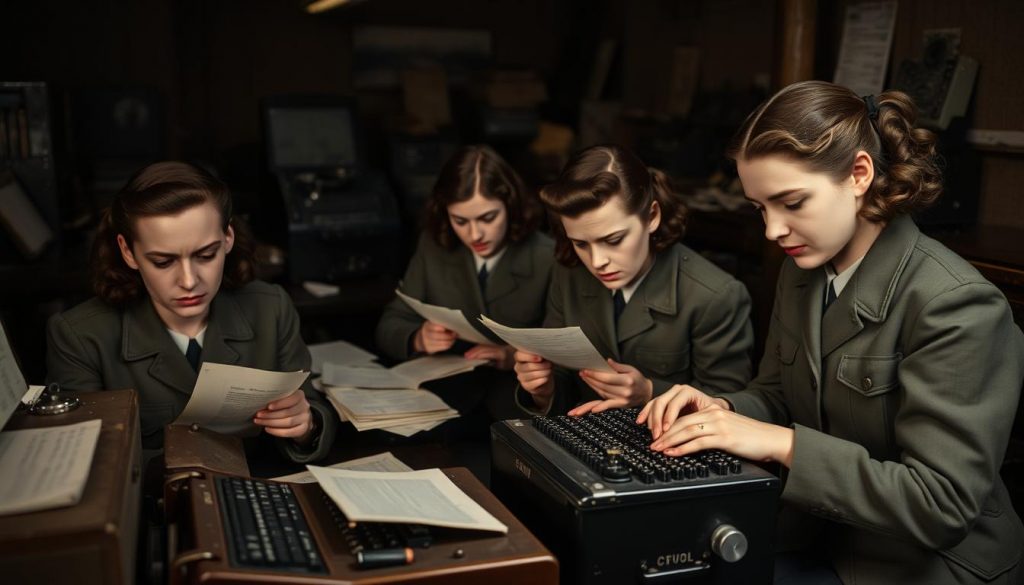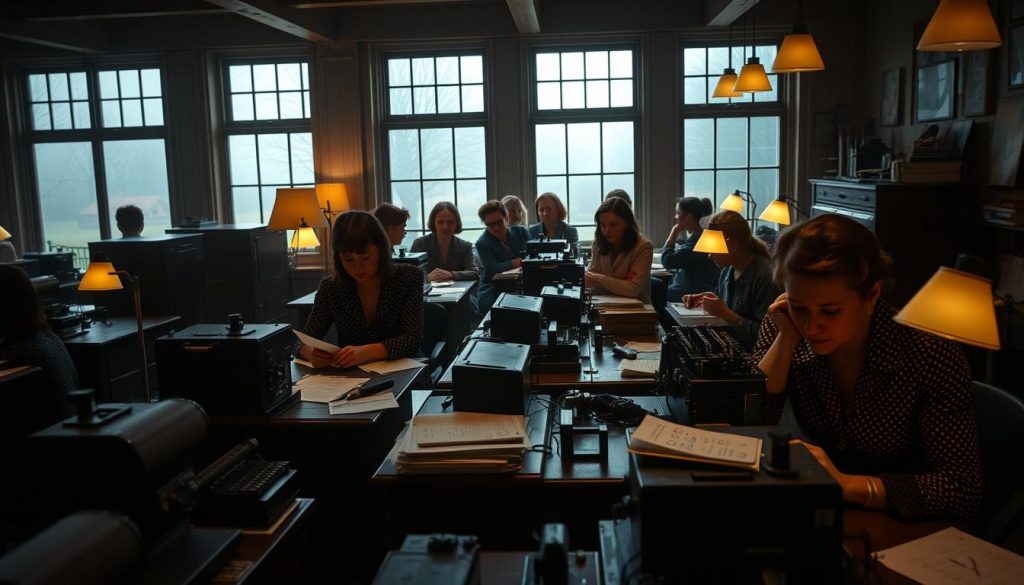The Forgotten Women Codebreakers of World War II.
During World War II, women codebreakers became unsung heroes. About 10,000 women were hired to decode enemy messages. They played a key role in the Allied victory.
Anúncios
These women came from different backgrounds, mostly from Seven Sisters colleges. They were good at math, astronomy, languages, and history. This made them perfect for the job.
They worked long hours, often 12 hours a day, 7 days a week. They used complex machines and listened to radio signals. Their hard work and smarts gave the Allies important information.
Despite facing sexism and unfair treatment, they stayed focused. They were seen as civilians at first but became vital to the military. Their work changed how we see women in war and military intelligence.
The Secret Recruitment of Female Code Breakers
During World War II, the U.S. government looked for the brightest minds from Seven Sisters colleges. They wanted women with great skills in math, astronomy, and languages.
Anúncios
The recruitment was very detailed and special. Women got mysterious letters asking them to join a secret project. These letters were designed to see if they could solve tough problems.
“We are seeking exceptional minds capable of unraveling complex puzzles for a critical wartime mission.”
- Targeted recruitment from prestigious Seven Sisters colleges
- Screening focused on academic skills in:
- Mathematics
- Foreign Languages
- History
- Astronomy
- Rigorous testing beyond traditional academic assessments
The search for codebreakers went beyond just schools. Teachers with sharp minds were also sought. By the end of the war, about 11,000 women were working on codebreaking.
| Recruitment Source | Number of Women |
|---|---|
| Seven Sisters Colleges | Approximately 500 |
| Schoolteachers | Estimated 2,500 |
| Other Academic Backgrounds | Around 8,000 |
These women’s skills were key in cracking enemy codes. They showed that brains have no gender.
Breaking the Gender Barrier: Women in Military Intelligence
During World War II, women played a key role in military intelligence. They challenged old gender roles and changed national security. At first, women worked in civilian codebreaking jobs. But they soon became vital to military service.
Women’s entry into intelligence work was a big change. About 10,000 women joined code-breaking efforts. More than half of the US code-breaking team were women.
“Women were not just supporting the war effort—they were actively changing its course through their intellectual contributions.” – Military History Researcher
- Women served in multiple military branches, including:
- Women’s Army Corps (WAC)
- WAVES (Women Accepted for Volunteer Emergency Service)
- WASP (Women Airforce Service Pilots)
Female codebreakers’ work was crucial. It helped military leaders like General Dwight D. Eisenhower. They could move men to combat roles, like for the Normandy landing.
| Year | Women in Military Intelligence Milestone |
|---|---|
| 1942 | Official integration of women into military service |
| 1943-1945 | Peak of women’s code-breaking contributions |
| 2013 | Combat exclusion policy lifted |
The wartime experiences of these women not only supported national defense but also paved the way for future generations of female military professionals.
The Rise of Women Codebreakers: From Civilians to Military Personnel

Women’s roles changed from civilian code breakers to military personnel during World War II. They took on key roles that changed national security. As the war grew, these women were key in solving codebreaking challenges for the Allies.
Entering military intelligence was tough for women. They went through tough screening and training. Many had skills in math, languages, and puzzles, which helped them in their jobs.
- More than 150,000 women served in the Women’s Army Corps (WAC)
- Recruitment centers in Washington DC trained specialized code breakers
- Long work hours became the norm, with shifts often extending to 12-hour days
The codebreaking challenges these women faced were huge. They worked hard, decoding enemy messages under pressure. Their mental strength was tested every day as they cracked Japanese and German codes, often working non-stop.
“We were doing something absolutely essential to winning the war, but we couldn’t tell anyone about it.” – Anonymous Code Girl
The start of WAVES (Women Accepted for Volunteer Emergency Service) was a big step for women in the military. These women showed that intelligence and hard work could break down gender barriers. They opened doors for future female military leaders.
Pioneering Figures: Elizebeth Friedman and Virginia Aderholt
During World War II, women changed the game in codebreaking. Elizebeth Friedman was a standout, moving from Shakespeare scholar to top cryptanalyst.
Her journey started with breaking Prohibition-era codes. She uncovered smuggler networks. In World War II, she helped take down a Nazi spy ring in South America.
“In a world dominated by men, Elizebeth Friedman proved that intelligence knows no gender.” – Intelligence History Archives
Virginia Aderholt was another key figure. She was the first American to learn of Japan’s surrender. This showed the vital role women played in military intelligence.
- Elizebeth Friedman helped capture over 1,500 enemy operatives
- Virginia Aderholt contributed to establishing crucial cryptographic operations
- Both women challenged gender stereotypes in intelligence work
| Codebreaker | Key Achievements | Impact |
|---|---|---|
| Elizebeth Friedman | Broke Prohibition-era criminal codes | Dismantled Nazi spy networks |
| Virginia Aderholt | First to decode Japan’s surrender message | Advanced military intelligence strategies |
Their groundbreaking work not only contributed to wartime success but also paved the way for future generations of women in cryptography and intelligence.
The Purple Machine: Genevieve Grotjan’s Breakthrough
In the secret world of World War II cryptography, Genevieve Grotjan became a hero. She was a math whiz from Buffalo, New York. Her work helped crack the Japanese Purple cipher, a code that had stumped military spies for months.
Grotjan’s path into cryptanalysis started with her amazing math skills. She graduated top of her class from the University at Buffalo in 1936. Her high score on a math test caught the eye of William Friedman at the Signal Intelligence Service (SIS).
“Her breakthrough would change the course of wartime intelligence gathering.” – Military Cryptography Historians
Her big moment was on September 20, 1940, when she was just 27. She found a way to break the Purple cipher. This code was used by Japanese diplomats and had been a secret fortress.
- Grotjan found a pattern in the Japanese code
- Her work let the U.S. read Japanese diplomatic messages
- This helped America’s war strategy a lot
Her work had a huge impact. The secrets from the Purple cipher helped win the Battle of Midway in June 1942. General George C. Marshall said these secrets saved lives and shortened the war.
Grotjan got a big raise for her work and more challenging tasks. Her success showed that women could excel in cryptanalysis.
In 2010, Genevieve Grotjan was honored in the NSA Hall of Honor. This recognized her as a trailblazer in cryptography.
Code Breaking Operations at Bletchley Park
Bletchley Park was the heart of British intelligence in World War II. It was where a group of codebreakers changed military strategy. Women played a key role in cracking the Enigma machine’s codes.

The codebreakers at Bletchley Park were a remarkable team. They broke gender norms. Here’s a look at who they were:
- Approximately 7,500 women worked at Bletchley Park
- Women made up about 75% of the workforce
- Six out of ten women were in the British Armed Forces
The way they were hired was unique. Cryptic crossword competitions helped find top talent. They looked for women with math skills, language abilities, and creative thinking.
“The performance of women codebreakers contributed to shortening the war by approximately two years.” – Intelligence Reports
They used cutting-edge technology to do their work. Women ran machines like the Colossus and Bombe. These machines were key to breaking Enigma codes. They worked in eight-hour shifts, showing great focus and dedication.
The women at Bletchley Park did more than just support the war effort. They were true intellectual warriors. Their skills and determination changed the course of World War II.
The Silent Warriors: Maintaining Wartime Secrecy
The world of wartime secrecy created a hidden world for the remarkable women codebreakers of World War II. These unsung heroes were bound by strict confidentiality agreements. Their extraordinary contributions were locked away from public knowledge.
“Silence was our most powerful weapon,” recalled one veteran codebreaker, highlighting the profound commitment to national security.
The post-war silence around their work defined their service. Many women took their incredible stories to their graves. They protected national secrets with unwavering dedication.
- Sworn to absolute confidentiality during wartime
- Prohibited from discussing cryptographic work
- Maintaining professional discretion for decades
Their sacrifice went beyond battlefield risks. These women knew that revealing classified information could harm military intelligence. It could also endanger ongoing operations.
| Secrecy Dimension | Impact |
|---|---|
| Personal Lives | Limited communication about professional experiences |
| Professional Development | Restricted career opportunities due to confidentiality |
| Historical Recognition | Delayed acknowledgment of critical contributions |
Only in recent decades have their remarkable stories begun to emerge. They shed light on the crucial role these silent warriors played. They protected national security during one of history’s most challenging periods.
Impact on Modern Cryptography and Intelligence
Women codebreakers in World War II changed cryptography and intelligence forever. Their work was key to national security and intelligence. It helped start new tech in these fields.
Women in STEM were crucial for agencies like the National Security Agency (NSA). Ann Caracristi was a trailblazer. She was the first woman to reach GS-18 and became NSA Deputy Director in 1980.
“The silent warriors of cryptography changed the landscape of intelligence forever.” – Intelligence History Archives
These women made big impacts:
- They broke complex cipher systems
- They created new cryptographic techniques
- They set up important ways to gather intelligence
- They started key computational strategies
By 1945, women made up 70% of Army code-breaking teams. This showed their amazing skills in cryptography.
Women like Genevieve Grotjan and Eileen Buckholtz changed tech and security. Their work helped make new systems and strategies.
Conclusion
The wartime legacy of women codebreakers is a key part of history. Over 10,000 women went to Washington, D.C. to help with critical work during World War II. They broke complex codes, saving lives and shortening the war.
It took time, but these women are now getting the recognition they deserve. More than 2,000 “Code Girls” played key roles in intelligence. They broke Japanese codes and created fake messages to confuse the enemy.
New documents and research show how these women changed military intelligence. Their work helped start the National Security Agency. It also showed women could excel in technical and strategic roles.
Looking back, we see these women as heroes, not just helpers. They showed us the power of diversity in solving big problems. Their stories inspire us today.
